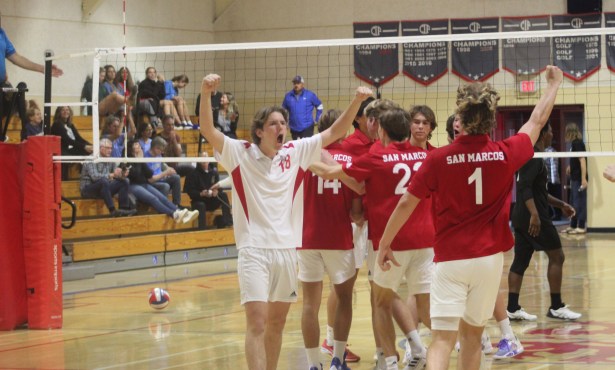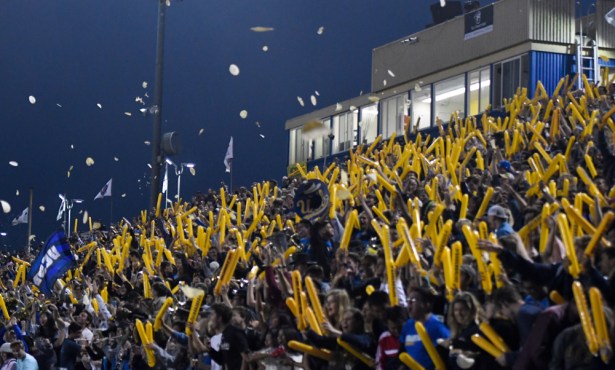Sporting-Sails
When the Barrel Never Closes Out
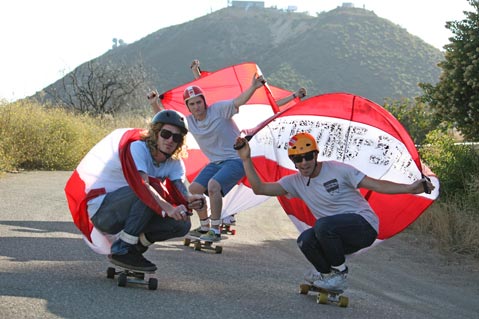
I can’t tell you the name of the road (it’s a secret), but I can say that it curves up into the Santa Ynez Mountains. Also, that Billy Smith drives a car like he skateboards: leaned back in a longboard stance and turning the wheel with a skateboarder’s delayed maneuver. But he’s so absurdly affable that there’s never any disquiet. Cresting the mountain, he talks about how matching air resistance with gravity and terminal speed changed the lives of him, his brother, and his friends.
The occasion for this road trip is a demo of Sporting-Sails, a flying squirrel-style parachute that Billy patented with his brother, Nick. A sail is deployed to decrease momentum, culling the wind to control the ride and relieving skaters of the necessity to drag their hands and feet. It attaches to the hands and ankles and has wide stripes of red and white — because, as Billy points out, no colors are more beautiful against the natural hues of California.
The point is descent. Add in a body-length sail, and how and what to descend changes. The responsiveness from your skateboard deck increases, and so does your ability to steady yourself. You can savor steeper gradients with a sail, carving down the hill rather than straight bombing it.
Manipulating the sail requires focus and control, but it doesn’t get in the way of the boarder’s raison d’être: rapture — the feeling of blissful expansion, like you’re absorbing the world all at once, the same kind of unbounded sensation that makes humans want to fly. This levity suspends not so much the body as it does the mind, releasing the inner ear from the pragmatics of gravity. In surfing, this is a momentary rush of ecstasy, but downhill skateboarding can extend it for 30-minutes. Instead of the flotsam and foam of white water rushing underneath, it’s the friction and grain of the road — a barrel that never closes out.
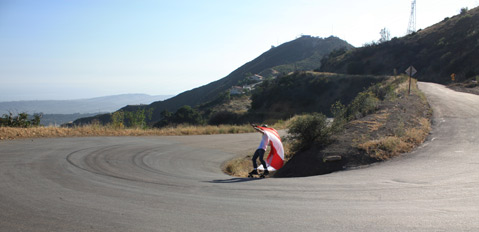
Rocket Boys
San Francisco magazine called them “the Wright brothers of landsurfing,” but Billy might be more akin to the Homer Hickam of skateboarding — the idealistic scientist leading a coterie of kindred skaters: his 21-year-old brother, business partner and student Nick; their childhood friend C.J.; a hair-stylist named Ryan; and a glass worker named Russ.
Billy is 25 and loves to sew and surf. Out of college, he interned at a rubber factory and designed sweaters for Banana Republic. When he heard about Patagonia’s entrance into the wetsuit market, he knocked on their door with a suitcase of designs. Billy was hired, moved to the area not knowing anybody, and met Ryan on the other side of his apartment wall.
Billy says that Ryan set the tenor for the group, which is perhaps true: Ryan’s type of cool is measured, shrewd, and chill, and immaculately executed with long yellow hair and a sleeve tattoo. Ryan is completely un-agitated; Billy is constantly stoked. And the equilibrium results in their indescribable trademark vibe.
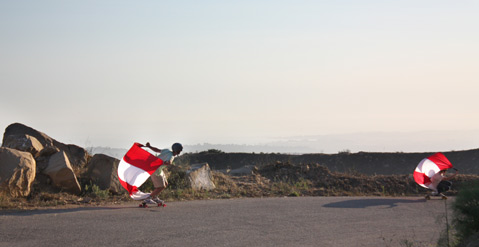
Reinvent the Descent
We pull over at an outrageous altitude, but the gradient looks reasonable. Car trunks open and the guys admire each other’s quiver of skateboards. They kick their flip-flops off and lace into sneakers.
“Reinvent the descent” is Billy’s phrase — referring to his sport’s departure from regular downhill skateboarding, but also to the act of rediscovery that the Sporting-Sail affords. To experience the mountain in a new kinesthetic way is to relearn the topography you thought you knew cold, a poetic sentiment easily ascribed to the mountainscapes of Santa Barbara, the distinctive east-west orientation of the Coastal Range and the Channel Islands on the ocean horizon.
“It’s a whole different way of drawing a line in the ground. Like right now, I’m looking down the slope and it kind of goes down like this, but with the sail you can hug that corner really well and get really in it,” Billy says, gesturing to a blind curve ahead, adding, “It’s a new adventure on the same ol’ skateboard.”
The boys are hanging out and reveling in the landscape between runs. It’s clear as they talk that the Sporting-Sail team lives in glorious proximity to the type of inspirational photography realized in Surfing Magazine: stories of sailing down hills on a full-moon midnight, pulling over on abandoned desert roads, long-distance skateboarding across Morocco. Billy confided a dream of seeing a row of Sporting-Sails — each printed with a different flag — flying down a mountain at the Winter Olympics’ opening ceremony.
Nick recalls sailing downhill on the Marin side of the Golden Gate Bridge: “A 500-foot sheer drop-off right into the Pacific Ocean. Just the Golden Gate Bridge right in front, and I have my two friends in front of me, seeing their silhouettes through the sail. It’s a moment of peace and clarity.” Then shifting to a tongue-in-cheek tone, “It’s kind of poetic, actually.”
“Yeah, it really is,” Billy agrees.
“The shadows and the light … it gets really intimate,” Ryan says.

A New Vert
As inventions go, the Sporting-Sail concept is very simple, but its construction is sophisticated. Billy holds the sail up to the light, talking about its luster, how it glows through a polarized lens. He holds it up to his mouth and blows into it, which makes a whistle sound. “No air is getting through that,” he enthuses, talking about the sail’s U.S. military-grade parachute fabric and Nylon bonded Tex 69 “E-thread.” There are hand loops, and the leg straps are much like those on surfboard leashes. The dimensions are 76 inches by 66 inches, and it also comes with a stuff sack.
“It’s like a fanny pack,” Billy says.
“Yeah, you can wear it with your cell phone and wallet and go out with it on,” says Nick.
“Yeah, a little fashion piece!” says Ryan.
Vertical (“vert”) skating allegedly started with the California drought of 1976, which evaporated swimming pools into proto-skate parks. What vert skating evolved into in the ’90s focused inextricably on tricks — and marketing the fashion and high-risk bravura that went with them. “Before skateboarding [became] about doing tricks, it was about surfing the land,” Ryan says, harkening to the stateliness that seems lost, “Sporting-Sails bring the surfing mentality back to skateboarding.”
Before driving back to town, they talk about how the Sporting-Sails philosophy is not about recapturing a lost art; it’s about forging something new. “We can come to a new place and check out a run that’s never been skated down before. And we could do it,” Billy says, “We could be the first descent.”
4•1•1
Sporting-Sails are also applicable to snowboarding and skiing and are sold exclusively in Santa Barbara at Arbor Collective, 1221 State Street. For more information, visit sporting-sails.com.

